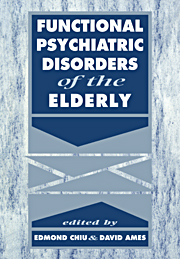Book contents
- Frontmatter
- Contents
- List of contributors
- Preface
- Introduction – A personal note
- Acknowledgement
- Part 1 Classification
- Part 2 General epidemiology
- Part 3 Neuroses
- 4 Panic disorders in the elderly
- 5 Obsessive–compulsive disorder in the elderly
- 6 Generalized anxiety and phobic disorders
- Part 4 Affective disorders
- Part 5 Psychosexual disorders
- Part 6 Substance use and abuse
- Part 7 Schizophrenia and related psychoses
- Part 8 Psychological, biological and medical issues
- Part 9 Treatment methods
- Part 10 Conclusion
- Index
6 - Generalized anxiety and phobic disorders
from Part 3 - Neuroses
Published online by Cambridge University Press: 13 November 2009
- Frontmatter
- Contents
- List of contributors
- Preface
- Introduction – A personal note
- Acknowledgement
- Part 1 Classification
- Part 2 General epidemiology
- Part 3 Neuroses
- 4 Panic disorders in the elderly
- 5 Obsessive–compulsive disorder in the elderly
- 6 Generalized anxiety and phobic disorders
- Part 4 Affective disorders
- Part 5 Psychosexual disorders
- Part 6 Substance use and abuse
- Part 7 Schizophrenia and related psychoses
- Part 8 Psychological, biological and medical issues
- Part 9 Treatment methods
- Part 10 Conclusion
- Index
Summary
Introduction
Anxiety and fear are affective components of a large number of psychiatric disorders. It has been calculated that 54 of the 208 disorders in the American Psychiatric Association's DSM-III-R classification (1987) include anxiety or fear to some extent (Delprato & McGlynn, 1984). As well as being part of other syndromes however, they also form the core of their own set of disorders, namely the generalized anxiety, phobic and panic disorders. Panic disorders are discussed in Chapter 5; this chapter will focus on generalized anxiety disorder (GAD) and phobic disorders in the elderly.
While dementia and depression in the elderly have been extensively researched, it has not been until comparatively recently that anxiety disorders have received similar attention. The reasons for this are complex, and include the ideas that anxiety and fear are a normal and reasonable part of old age, that anxiety disorders are not important in the elderly, and also therapeutic nihilism on the part of clinicians. These preconceptions do not appear to be supported by research. For example, in the Epidemiologic Catchment Area (ECA) study, a 4.8% prevalence rate of phobic disorder in people over the age of 65 was identified in five areas of the United States (Regier et al., 1988). This is a small but significant minority of people who are high consumers of health and social services' resources, and there are therapeutic strategies which can effectively address their anxiety and phobias.
- Type
- Chapter
- Information
- Functional Psychiatric Disorders of the Elderly , pp. 78 - 92Publisher: Cambridge University PressPrint publication year: 1994



